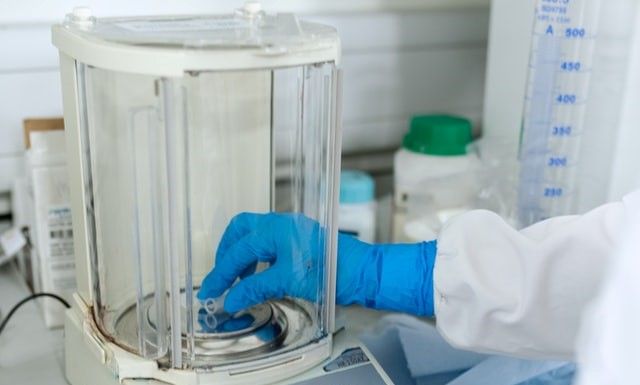What are nanomaterials?
While there is no unanimous scientific definition of a nanomaterial, they are all so small that they are measured in nanometres (1nm = 1 millionth of a millimetre) and are comparable in size to atoms and molecules. Most nanoparticles measure less than 100 nanometres wide (or 1/10,000th the thickness of a human hair).
How can nanomaterials be used and handled if they are so small?
The appearance of nanoparticles varies depending on their form and what they are made of. However, when clumped together, carbon nanotubes look a lot like iron fillings and feel like a powder. This makes them easy to transport in any air-tight, sealed container.
Why are nanomaterials so useful?
Materials at the nanoscale function differently than at the macroscale. This means that a material such as carbon can be magnetic at the nanoscale when it is not magnetic at the macroscale, all while still maintaining the properties that make carbon so practical.

Additionally, because of their small size, nanomaterials have a large surface area to volume. This means that when mixed together, nanomaterials can have a large impact on the properties of a bulk material.
What substances are typically used as nanoscale raw materials?
A wide variety of materials are used in at the nanoscale; however, the most common substances are silver, carbon, zinc, gold, titanium dioxide, aluminium oxide, copper, silica, titanium boride, nickel, and calcium carbonate.
How are nanomaterials made?
There are two main processes for the production of nanomaterials.
1. Top down – Individual particles or 2D sheets are sliced away or extracted by a mechanical process from a larger piece of bulk material.
2. Bottom up – A range of processes which take a material at a smaller form and make it bigger. For example, individual atoms can be dissolved in a solution and a chemical reaction can cause the atoms to clump together in a precise form to create the desired nanoparticle or nanoscale structure.
One of the most common ‘bottom up’ processes is chemical vapour deposition (CVD) where a solid is synthesized onto a surface by reaction to a gaseous source material. Its popularity is based on its simplicity and the fact that it can often be conducted at ambient temperature and pressure - reducing costs.
Are nanomaterials safe?
People working with nanomaterials should take care not to inhale nanoparticles. For this reason, most workers use face masks and googles to prevent excessive absorption. Some nanomaterials require extra-special handling with equipment such as gloves boxes.
Once the nanomaterials are included inside an end product, they are as safe as other chemical raw materials. For this reason, as the European Union Observatory for Nanomaterials states, “nanomaterials are covered by the same rigorous regulatory framework that ensures the safe use of all chemicals and mixtures, i.e., the REACH and CLP regulations.” They are widely used in hundreds of thousands of everyday products, and if safety procedures are followed in the workplace pose the same risk to health as other raw materials or chemicals.

Which industries use nanomaterials?
Nanomaterials are widely used in pharmaceuticals, aerospace, composites, electronics, rubbers, construction chemicals, as industrial catalysts for the chemical industry, pesticides, herbicides, fertilizers, plastics, resins, metals, coatings, sunscreens, cosmetics, and more.
How can nanomaterials improve manufacturing?
1. Nanomaterials can add desirable properties to a bulk material such as a polymer or resin. They can make materials antibacterial, flexible, stronger, more rigid, electromagnetic, electrically conductive, UV resistant, and more.
For example, by adding specific nanomaterials to the composites that make up the body of an aircraft, the material can be made stronger, more flexible, lighter, as well as be given electrical conductivity to help protect against electrostatic discharge and lightning strikes.
2. Nanomaterials can reduce raw material costs. Nanomaterials can often replace traditional bulk materials at a lower price.
For example, carbon nanotubes can be used in tyre production in place of carbon black. Because of their high efficiency and low weighting, much less nanomaterial is needed then bulk carbon black. The use of nanomaterials can actually lower raw material costs.
3. Reduced application, labour, and energy costs.
Because nanomaterials can do more for less, delivery costs can be reduced.

They can also make give materials a lower melting point, potentially lessening energy costs.
Additionally, nanomaterials can add properties that reduce the manhours need to apply a product. For example, when added to epoxy flooring systems they can drastically reduce curing times.
What is the next step for introducing nanomaterials into a production process?
Draw up a list of what you would like your products to do. Maybe you would like your rubber materials to be more flexible, or stiffer. Perhaps your plastics would sell better if they were more scratch resistant. Do you have a PVC product which would benefit from added thermal or electrical conductivity? Or maybe you know a customer who is looking for a plastic sheeting with antimicrobial properties.
Once you have decided how you would like your product or manufacturing processes improved, contact a firm that specialises in nanotechnology to see how they can help you.

NANO CHEMI GROUP are experts in solving the problems of manufacturing with nanotechnology.
The company (which hosts this website) works closely with European research institutes; focusing on the development and production of solutions based on nanomaterials, which it supplies to industrial customers. Their work over the last five years has already borne fruit, as they are currently patenting carbon addition technologies and have received a European Union grant worth €650,000 to build a nanotechnology centre that will become operational later this year.
No one knows the shortfalls of your product range better than you. Nor does anyone understand your customer demands or how your business can grow better as well as you. So, decide what your product improvement wish list is and then arrange to meet one of NANO CHEMI GROUP’s nanomaterial specialists to find out how they can help you achieve your goals.
Call +420 233 371 850 or visit NANO CHEMI GROUP or complete a simple online enquiry form to find out how nanotechnology can boost your business.
Photo credit: AG CHEMI GROUP, freepik, Hongying Pan on Unsplash, ThisisEngineering,
